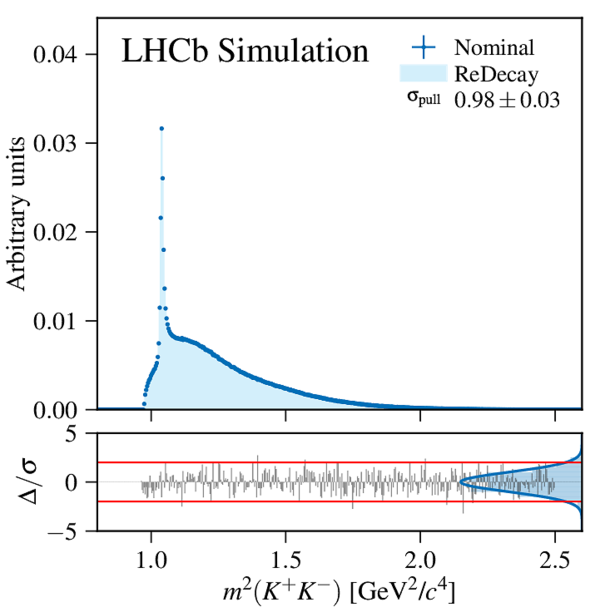Information
LHCb-DP-2018-004
arXiv:1810.10362 [PDF]
(Submitted on 24 Oct 2018)
Eur. Phys. J. C 78 (2018) 1009
Inspire 1700169
Tools
Abstract
With the steady increase in the precision of flavour physics measurements collected during LHC Run 2, the LHCb experiment requires simulated data samples of larger and larger sizes to study the detector response in detail. The simulation of the detector response is the main contribution to the time needed to simulate full events. This time scales linearly with the particle multiplicity. Of the dozens of particles present in the simulation only the few participating in the signal decay under study are of interest, while all remaining particles mainly affect the resolutions and efficiencies of the detector. This paper presents a novel development for the LHCb simulation software which re-uses the rest of the event from previously simulated events. This approach achieves an order of magnitude increase in speed and the same quality compared to the nominal simulation.
Figures and captions
|
Illustration of the correlations between events produced with the ReDecay method, using $N_{\text{ReDecay}}=100$: (left) autocorrelation function $R(\tau)$ for different values of the ratios of widths of the probability density functions, $\sigma_2/\sigma_1$ and (right) comparison of normalised distributions of a variable $x$ generated with the ReDecay method and a standard generation method (nominal) for $\sigma_1=5$ and $\sigma_2=1$. The bottom part of the right plot shows the pull distribution of the difference $\Delta$ in each bin of the distribution of the value obtained with the ReDecay method with the value from the nominal method, divided by the naive expectation for the statistical undertainty, $\sigma = \sqrt{N}$ where $N$ is the number of events in the bins. A unit Gaussian distribution is overlaid with the pull distribution to visualize their disagreement. The pull distribution has a width of $1.75\pm0.09$ indicating that uncertainties are underestimated in this illustration case. |
autoco[..].pdf [197 KiB] HiDef png [237 KiB] Thumbnail [152 KiB] |

|
|
dummy_[..].pdf [243 KiB] HiDef png [294 KiB] Thumbnail [175 KiB] |

|
|
|
Comparison of a ReDecay sample with a nominally produced sample of $ D ^0 \rightarrow K ^- K ^+ \pi ^+ \pi ^- $ decays. Shown are the invariant mass squared of the kaon pair (left) and pion pair (right) which are both independent of the kinematics of the decaying particle. Displayed uncertainties are computed assuming independent events. There is no sign of the effects caused by correlated events as seen in \cref{fig:illustration} (right). |
dtok3p[..].pdf [351 KiB] HiDef png [271 KiB] Thumbnail [187 KiB] |

|
|
dtok3p[..].pdf [351 KiB] HiDef png [271 KiB] Thumbnail [187 KiB] |

|
|
|
Animated gif made out of all figures. |
DP-2018-004.gif Thumbnail |

|
Created on 18 October 2023.
